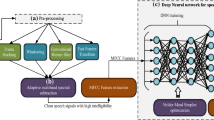Abstract
The measurement of the speech-evoked auditory brainstem response (speech ABR) is a promising technique for evaluating auditory function. However, the speech ABR is severely contaminated by background noise related to other brain electrical activity. The most commonly used method to enhance the signal-to-noise ratio (SNR) of the response is coherent averaging, while recently adaptive filtering has also been reported. All of the applied methods are based on linear operations, but since the assumption of linearity may not be valid for neural activity, linear methods may not be adequate. In this paper, we present a new nonlinear adaptive noise cancellation (ANC) based on a multilayer perceptron neural network to enhance the speech ABR and compare its performance with a linear ANC algorithm based on least mean squares adaptive filtering. The effectiveness of the methods is tested using speech ABR data and is based on two different types of SNR measures, the local SNR at the fundamental frequency of the response and the overall SNR. The results show that the nonlinear neural network-based ANC can reduce the required recording time and performs better than the linear ANC especially when the SNR of the recorded speech ABR is low.





Similar content being viewed by others

References
Boston, J.R., Moller, A.R.: Brainstem auditory-evoked potentials. Crit. Rev. Biomed. Eng. 13(2), 97–123 (1985)
Johnson, K.L., Nicol, T.G., Kraus, N.: Brain stem response to speech: a biological marker of auditory processing. Ear Hear. 26(5), 424–434 (2005)
Vander-Werff, K.R., Burns, K.S.: Brainstem responses to speech in younger and older adults. Ear Hear. 32(2), 168–180 (2011)
Russo, N., Nicol, T., Musacchia, G., Kraus, N.: Brainstem responses to speech syllables. Clin. Neurophysiol. 115(9), 2021–2030 (2004)
Aiken, S.J., Picton, T.W.: Envelope and spectral frequency-following responses to vowel sounds. Hear. Res. 245(1–2), 35–47 (2008)
Dajani, H.R., Purcell, D., Wong, W., Kunov, H., Picton, T.W.: Recording human evoked potentials that follow the pitch contour of a natural vowel. IEEE Trans. Biomed. Eng. 52(9), 1614–1618 (2005)
Laroche, M.H., Dajani, H.R., Prévost, F., Marcoux, A.M.: Brainstem auditory responses to resolved and unresolved harmonics of a synthetic vowel in quiet and noise. Ear Hear. 34(1), 63–74 (2012)
Prévost, F., Laroche, M., Marcoux, A.M., Dajani, H.R.: Objective measurement of physiological signal-to-noise gain in the brainstem response to a synthetic vowel. Clin. Neurophysiol. 124(1), 52–60 (2013)
McNamara, D.M., Ziarani, A.K.: A new adaptive technique of estimation of steady state auditory evoked potentials. In: Conference on proceedings of IEEE engineering in medicine and biology society 26, pp. 4544–4547 (2004)
Cheah, L.A., Hou, M.: Real-time detection of auditory steady-state responses. In: Conference on proceedings of IEEE engineering in medicine and biology society, pp. 1382–1385 (2010)
Van Dun, B., Wouters, J., Moonen, M.: Improving auditory steady-state response detection using independent component analysis on multichannel EEG data. IEEE Trans. Biomed. Eng. 54(7), 1220–1230 (2007)
Fallatah, A.: Enhancement of speech auditory brainstem responses using adaptive filters. M.A.Sc Thesis, University of Ottawa (2012)
Stam, C.J.: Nonlinear dynamical analysis of EEG and MEG: Review of an emerging field. Clin. Neurophysiol. 116(10), 2266–2301 (2005)
Gholami-Boroujeny, S., Eshghi, M.: Active noise control using an adaptive bacterial foraging optimization algorithm. Signal Image Video Process., 1–10 (2012). doi:10.1007/s11760-012-0385-2
Mihandoost, S., Chehel Amirani, M.: EEG signal analysis using spectral correlation function and GARCH model. Signal Image Video Process., 1–12 (2014). doi:10.1007/s11760-013-0600-9
Kumar, Y., Dewal, M.L., Anand, R.S.: Epileptic seizures detection in EEG using DWT-based ApEn and artificial neural network. Signal Image Video Process., 1–12 (2012). doi:10.1007/s11760-012-0362-9
Zeng, Y., Zhang, J., Yin, H., Pan, Y.: Visual evoked potential estimation by adaptive noise cancellation with neural-network-based fuzzy inference system. J. Med. Eng. Technol. 31(3), 185–190 (2007)
Hu, Y.H., Tompkins, W.J., Urrusti, J.L., Afonso, V.X.: Application of artificial neural networks for ECG signal detection and classification. J. Electrocardiol. 26, 66–73 (1993)
Camps, G., Martinez, M., Soria, E.: Fetal ECG extraction using an FIR neural network. In: Conference on proceedings of IEEE computers in cardiology, pp. 249–252 (2001)
Selvan, S., Srinivasan, R.: Removal of ocular artifacts from EEG using an efficient neural network based adaptive filtering technique. IEEE Signal Process. Lett. 6(12), 330–332 (1999)
Hamzaoui, E., Regragui, F., Himmi, M.M., Mghari, A.: Visual evoked potentials’ non linear adaptive filtering based on three layers perceptron. J. Appl. Math. Sci. 4(56), 2759–2772 (2010)
Nair, M.S., Shanker, V.: Predictive-based adaptive switching median filter for impulse noise removal using neural network-based noise detector. Signal Image Video Process. 7(6), 1041–1070 (2013)
Tian, J., Juhola, M., Grönfors, T.: Latency estimation of auditory brainstem response by neural networks. Artif. Intell. Med. 10(2), 115–128 (1997)
Subasi, A., Erçelebi, E.: Classification of EEG signals using neural network and logistic regression. Comput. Methods Progr. Biomed. 78(2), 87–99 (2005)
Majumdar, K.: Human scalp EEG processing: various soft computing approaches. Appl. Soft Comput. 11(8), 4433–4447 (2011)
Haykin, S.: Adaptive Filter Theory. Prentice-Hall, Upper Saddle River (2002)
Widrow, B., Stearns, S.: Adaptive Signal Processing. Prentice-Hall, Upper Saddle River (1985)
Hecht-Nielsen, R.: Theory of the backpropagation neural network. In: Conference on proceedings of IEEE neural networks, IJCNN, pp. 593–605 (1989)
Haykin, S.: Neural Networks: A Comprehensive Foundation. Prentice-Hall, Upper Saddle River (1999)
Widrow, B., Glover, J.R., McCool, J.M.: Adaptive noise cancelling: principles and applications. Proc. IEEE 63(12), 1692–1716 (1975)
Acknowledgments
This study was funded in part by the Natural Sciences and Engineering Research Council of Canada. Ethics approval for the experimental work was given by the University of Ottawa Research Ethics Board. There are no competing interests to declare.
Author information
Authors and Affiliations
Corresponding author
Rights and permissions
About this article
Cite this article
Gholami-Boroujeny, S., Fallatah, A., Heffernan, B.P. et al. Neural network-based adaptive noise cancellation for enhancement of speech auditory brainstem responses. SIViP 10, 389–395 (2016). https://doi.org/10.1007/s11760-015-0752-x
Received:
Revised:
Accepted:
Published:
Issue Date:
DOI: https://doi.org/10.1007/s11760-015-0752-x



